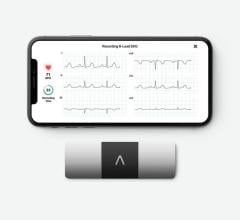
April 4, 2013 — iRhythm Technologies Inc. announced clinical study findings showing that use of the Zio Patch resulted in a change in treatment strategy for nearly one-third of patients with paroxysmal atrial fibrillation (AF). The data, which was published in Pacing and Clinical Electrophysiology (PACE) Journal on March 12, showed that the Zio Patch ambulatory cardiac monitoring system demonstrated improved clinical accuracy and detection of potentially malignant arrhythmias in AF patients compared with a 24-hour Holter monitor in the same patients.
The self-controlled study, conducted by Michael A. Rosenberg, Peter J. Zimetbaum and colleagues at Beth Israel Deaconess Medical Center’s Division of Electrophysiology in Boston, compared iRhythm’s Zio Patch to a 24-hour Holter monitor in 74 patients with AF who were referred for monitoring to detect and characterize their arrhythmias.
“The findings from this peer-reviewed research further validate the clinical and patient benefits of the Zio Patch and support its progression toward becoming a new standard of care for ambulatory cardiac rhythm diagnostics,” said Kevin King, iRhythm’s president and chief executive officer. “iRhythm is committed to providing high-yield diagnostic data via a very simple solution for clinicians and their cardiac patients who have not benefited from significant innovation in the field of ambulatory cardiac monitoring in many years.”
“The results of this peer-reviewed study corroborate what we consistently see in everyday practice, which is that the combination of improved patient compliance and longer-term monitoring can enable physicians to better detect episodes of paroxysmal atrial fibrillation and make more informed treatment decisions based upon this clinical information,” said Judy Lenane, chief clinical officer for iRhythm. “Patients have consistently expressed appreciation for the low-profile, wire-free form factor of the Zio Patch, which enables them to shower and go about their daily activities without the bulk and discomfort of a traditional Holter.”
Study Results
Overall, the study results showed that the Zio Patch was superior to a 24-hour monitor in detecting AF episodes and comparable in quantifying AF burden. Specifically, the Zio Patch identified AF episodes in 35 percent of patients who were found to have no AF by the Holter monitor. The Zio Patch also provided the additional benefit of detecting other more malignant arrhythmias due to the longer duration of detection. These benefits led to clinically meaningful changes in the existing treatment plans for 21 of the study patients (28.4 percent of study participants).
The Zio Patch was well tolerated by a majority of the study participants, with a mean wear time of 10.8 days (range of 4-14 days overall).
The study concluded that the promising data from this pilot study suggests that the Zio Patch device may represent a more convenient and efficient method of outpatient arrhythmia detection than current methods using Holter monitors, event recorders or mobile cardiac outpatient telemetry.
For more information: www.irhythmtech.com


 November 21, 2023
November 21, 2023 








